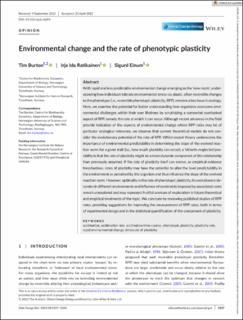Environmental change and the rate of phenotypic plasticity
Peer reviewed, Journal article
Published version

Åpne
Permanent lenke
https://hdl.handle.net/11250/3049256Utgivelsesdato
2022Metadata
Vis full innførselSamlinger
- Publikasjoner fra CRIStin - NINA [2364]
- Scientific publications [1392]
Sammendrag
With rapid and less predictable environmental change emerging as the ‘new norm’, understanding how individuals tolerate environmental stress via plastic, often reversible changes to the phenotype (i.e., reversible phenotypic plasticity, RPP), remains a key issue in ecology. Here, we examine the potential for better understanding how organisms overcome environmental challenges within their own lifetimes by scrutinizing a somewhat overlooked aspect of RPP, namely the rate at which it can occur. Although recent advances in the field provide indication of the aspects of environmental change where RPP rates may be of particular ecological relevance, we observe that current theoretical models do not consider the evolutionary potential of the rate of RPP. Whilst recent theory underscores the importance of environmental predictability in determining the slope of the evolved reaction norm for a given trait (i.e., how much plasticity can occur), a hitherto neglected possibility is that the rate of plasticity might be a more dynamic component of this relationship than previously assumed. If the rate of plasticity itself can evolve, as empirical evidence foreshadows, rates of plasticity may have the potential to alter the level predictability in the environment as perceived by the organism and thus influence the slope of the evolved reaction norm. However, optimality in the rate of phenotypic plasticity, its evolutionary dynamics in different environments and influence of constraints imposed by associated costs remain unexplored and may represent fruitful avenues of exploration in future theoretical and empirical treatments of the topic. We conclude by reviewing published studies of RPP rates, providing suggestions for improving the measurement of RPP rates, both in terms of experimental design and in the statistical quantification of this component of plasticity. acclimation, acclimation rate, acclimation time-course, phenotypic plasticity, plasticity rate, rapid environmental change, timescale of plasticity
